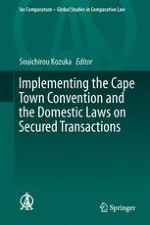2017 | OriginalPaper | Buchkapitel
2. The Cape Town Convention and Its Implementation in Domestic Law: Between Tradition and Innovation
verfasst von : Souichirou Kozuka
Erschienen in: Implementing the Cape Town Convention and the Domestic Laws on Secured Transactions
Aktivieren Sie unsere intelligente Suche, um passende Fachinhalte oder Patente zu finden.
Wählen Sie Textabschnitte aus um mit Künstlicher Intelligenz passenden Patente zu finden. powered by
Markieren Sie Textabschnitte, um KI-gestützt weitere passende Inhalte zu finden. powered by
